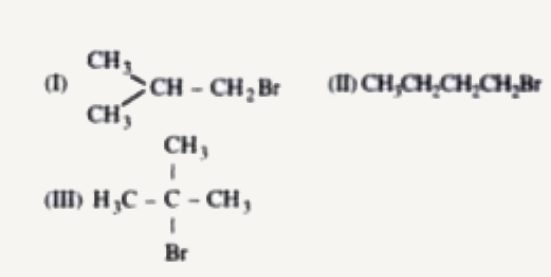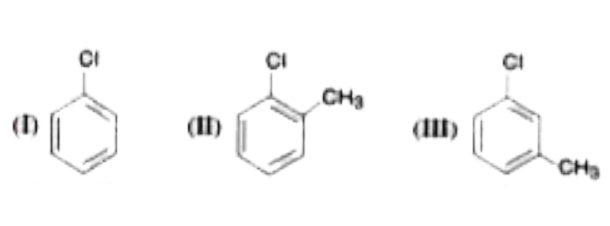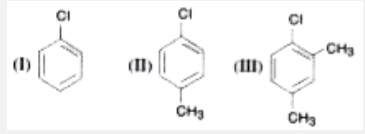Complete Solutions to EXERCISE (PART - I OBJECTIVE QUESTIONS) (MULTIPLE CHOICE QUESTIONS) of chapter HALOALKANES AND HALOARENES of Class 12 book with complete answers and questions
| Class 12 | CHEMISTRY |
| Chapter | HALOALKANES AND HALOARENES |
| KALYANI PUBLICATION | EXERCISE (PART - I OBJECTIVE QUESTIONS) (MULTIPLE CHOICE QUESTIONS) |
| Number Of Questions | 40 |
| Academic Year | 2023-24 |
Alkyl halides react with metallic sodium in dry ether producing
03:01View SolutionBy heating a mixture of `CHCl_3` with silver powder, the compound formed is
01:06View SolutionMethyl alcohol reacts with phosphorus trichloride to form
01:07View SolutionWrite the reactions between methane and chlorine in the presence of diffused sunlight.
01:40View SolutionWhich of the following is gem halide ?
01:57View SolutionWhich one is formed when sodium phenoxide is heated with ethyl iodide ?
01:39View SolutionOn heating chloroform with aqueous potash we get
02:58View SolutionThe reaction conditions leading to the best yield of `C_2H_5Cl` are
08:09View SolutionOut of the following compounds, which one will have a zero dipole moment?
02:13View SolutionThe order of reactivity of following alcohols with halogen acids is _______.
`CH_3CH_2-CH_2-OH`
`CH_3CH_2-underset(CH_3)underset(|)"CH"-OH`
`CH_3CH_2-underset(CH_3)underset(|)overset(CH_3)overset(|)C-OH`02:12View SolutionWhich of the following alcohols will yield the corresponding alkyl chloride on reaction with concentrated HCl at room temperature?
03:42View SolutionIdentify the compound Y in the following reaction :
 01:49View Solution
01:49View SolutionToluene react with a halogen in the presence of iron (III) chloride giving ortho andpara halo compounds. The reactions is
06:45View SolutionWhich of the following is halogen exhange reaction?
02:46View SolutionWhich reagent will you use for the following reaction ?
`CH_3 CH_2 CH_2 CH_3 to CH_3 CH_2 CH_2 CH_2 Cl + CH_3CH_2 CHClCH_3`02:27View SolutionArrange the following compounds in the increasing order of their densities.
 03:43View Solution
03:43View SolutionArrange the following compounds in increasing order of their boiling points.
 02:21View Solution
02:21View SolutionIn which of the following molecules carbon atom marked with asterik (*) is asymmetric ?
 04:09View Solution
04:09View SolutionMatch the following :
 06:24View Solution
06:24View SolutionWhich of the following is an example of vic-dihalide?
03:06View SolutionThe position of Br in the compound in `CH_(3)=CHC(Br)(CH_(3))_(2)` can be classified as……..
02:25View SolutionChlorobenzene is formed by reaction of chlorine with benzene in the presence of `AlCl_3`. Which of the following? Species attacks the benzene ring in this reaction ?
02:02View SolutionEthylidene chloride is a/an…..
02:05View SolutionWhat is 'A' in the following reaction ?
 04:10View Solution
04:10View SolutionA primary alkyl halide would prefer to undergo…….
01:56View SolutionWhich of the following alkyl halides will undergo `S_(N^1)` reaction most readily?
02:28View SolutionWhat is the correct IUPAC name for
`CH_3-underset(C_2H_5)underset(|)"CH"-CH_2-Br ?`01:36View SolutionWhat should be the correct IUPAC name for diethylbromomethane?
01:54View SolutionThe reaction of toluene with chlorine in the presence of iron and in the absence of light yields_____.
02:27View SolutionChloromethane on treatment with excess of ammonia yields mainly
02:29View SolutionMolecules whose mirror image is non-superimposable over them are known as chiral. Which of the following molecules is chiral in nature ?
05:30View SolutionReaction of `C_6H_5CH_2Br` with aqueous sodium hydroxide follows........
02:34View SolutionBond energies can be obtained by using the following relation: `DeltaH (reaction) = sum`Bond energy of bonds, broken in the reactants `-sum` Bond energy fo bonds, formed in the products
Bond enegry depends on three factors:
a. Greater is the bond length, lesser is the bond enegry.
b. Bond energy increases with the bond multiplicity.
c. Bond enegry increases with electronegativity difference between the bonding atoms.
In `CH_(4)` molecule, which of the following statement is correct about the `C -H` bond enegry?01:34View SolutionWhich of the following compounds will give racemic mixture on nucleophilic substitution by `OH^(-)` ion?
`(I) CH_3-underset(C_2H_5)underset(|)"CH"-Br`
(II) `CH_3-underset(C_2H_5)underset(|)overset(Br)overset(|)C-CH_3`
05:54View SolutionArrange the compounds in increasing order of rate of reaction towards nucleophilic substitution.
 03:32View Solution
03:32View SolutionArrange the compounds in increasing order of rate of reaction towards nucleophilic substitution.
 03:32View Solution
03:32View SolutionArrange the compounds in increasing order of rate of reaction towards nucleophilic substitution.
 03:32View Solution
03:32View SolutionArrange the compounds in increasing order of rate of reaction towards nucleophilic substitution.
 03:30View Solution
03:30View SolutionWhich of the correct increasing order of boiling points of the following compounds?
1-Iodobutane,1-Bromobutane,1-Chlorobutane, Butane03:49View SolutionWhich is the correct increasing order of boiling points of the following compounds?
1-Bromoethane,1-Bromopropane,1-Bromobutane,Bromobenzene04:52View Solution
EXERCISE (PART - I OBJECTIVE QUESTIONS) (MULTIPLE CHOICE QUESTIONS) questions and complete solutions for chapter HALOALKANES AND HALOARENES of KALYANI CHEMISTRY (ENGLISH) of Class 12
All Exercises from KALYANI PUBLICATION Class 12 CHEMISTRY HALOALKANES AND HALOARENES
- EXERCISE (PART - I OBJECTIVE QUESTIONS)
- EXERCISE (PART - I OBJECTIVE QUESTIONS) (CORRECT THE FOLLOWING STATEMENTS)
- EXERCISE (PART - I OBJECTIVE QUESTIONS) (FILL IN THE BLANK)
- EXERCISE (PART - I OBJECTIVE QUESTIONS) (MULTIPLE CHOICE QUESTIONS)
- EXERCISE (PART - II DESCRIPTIVE QUESTIONS) (LONG ANSWER QUESTIONS)
- EXERCISE (PART - II DESCRIPTIVE QUESTIONS) (SHORT ANSWER QUESTIONS)
- EXERCISE (PART - II DESCRIPTIVE QUESTIONS) (VERY SHORT ANSWER QUESTIONS)
- FILL IN THE BLANKS
- INTEXT QUESTIONS
- ISC EXAMINATION QUESTIONS
- MATCH
- MULTIPLE CHOICE QUESTIONS
- REACTION BASED
- SOURCE
